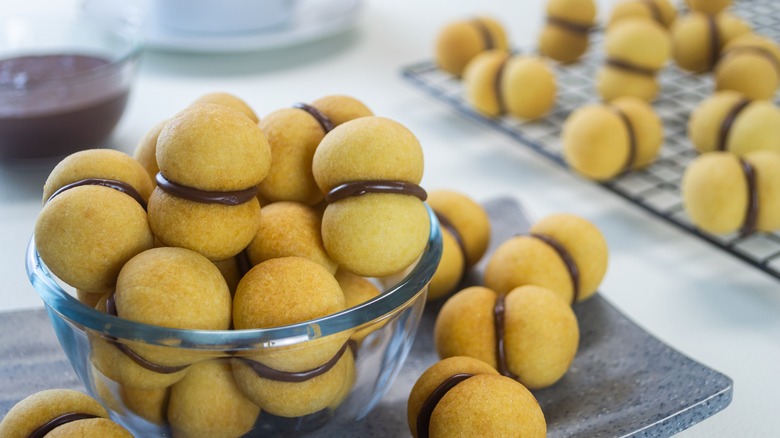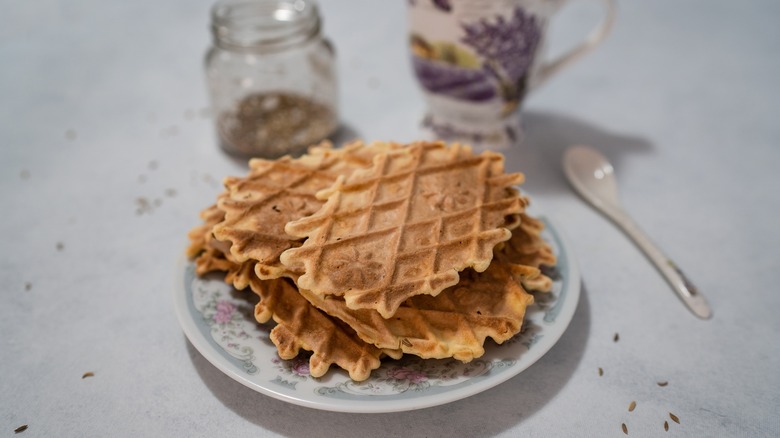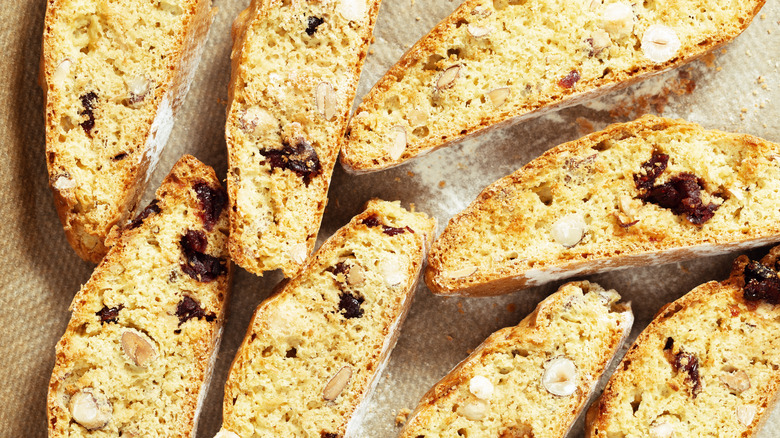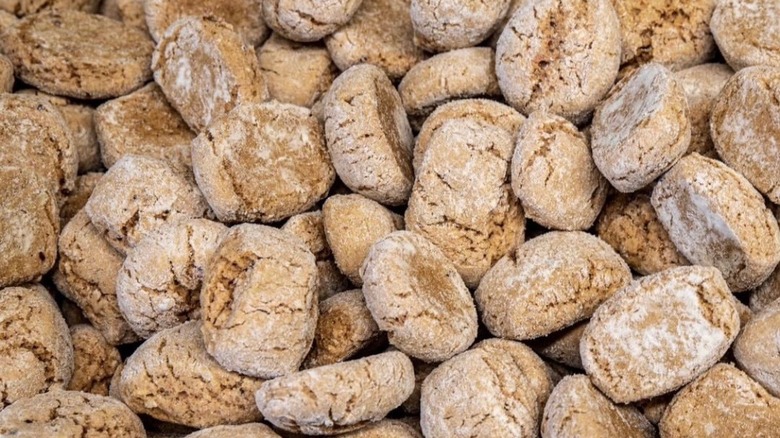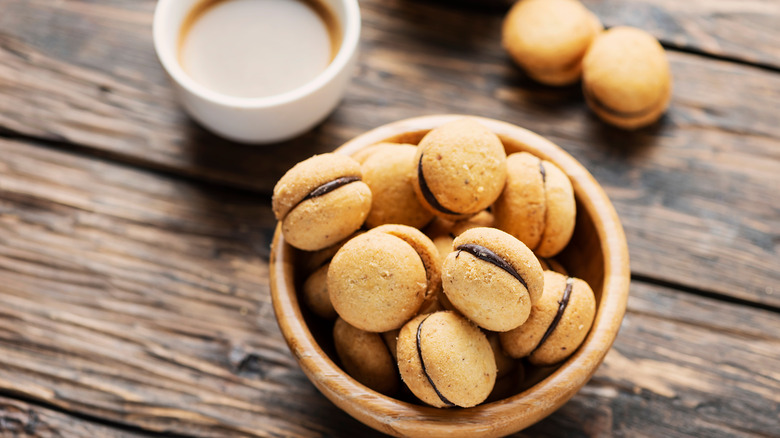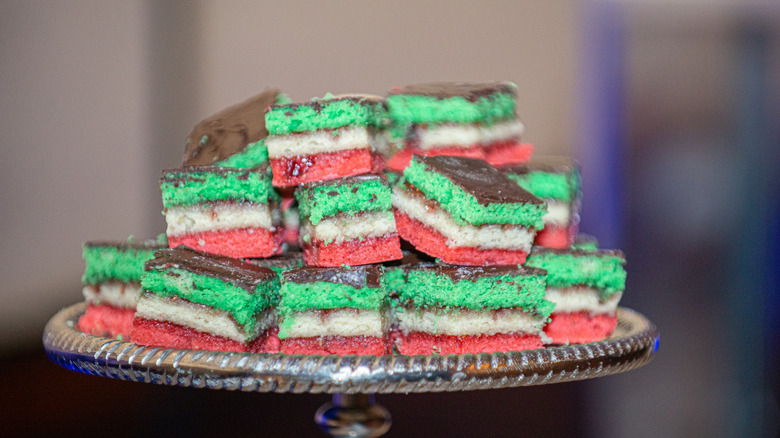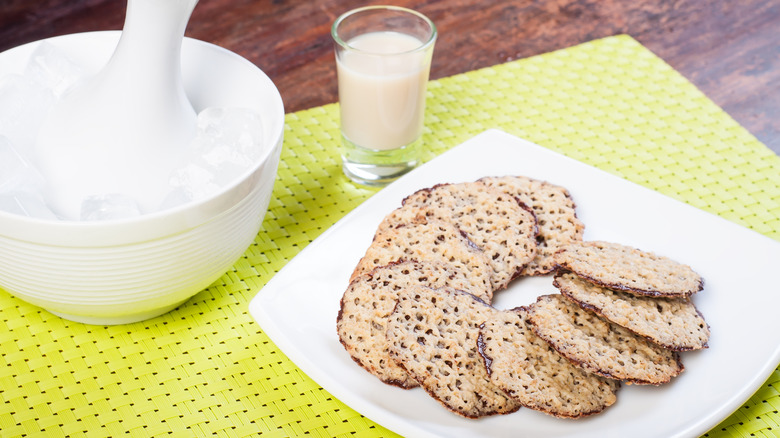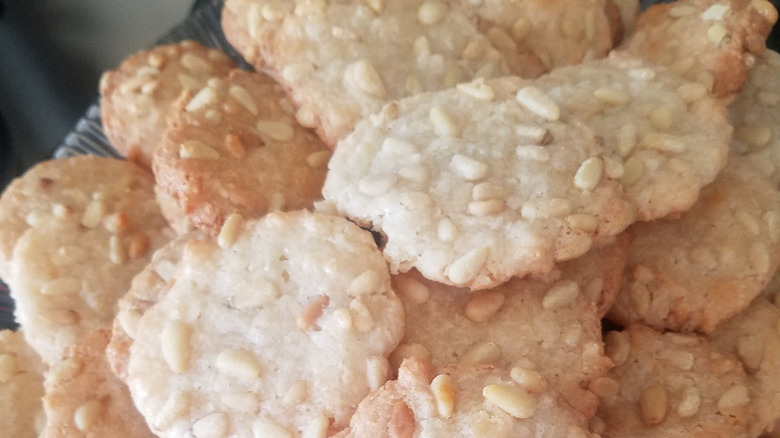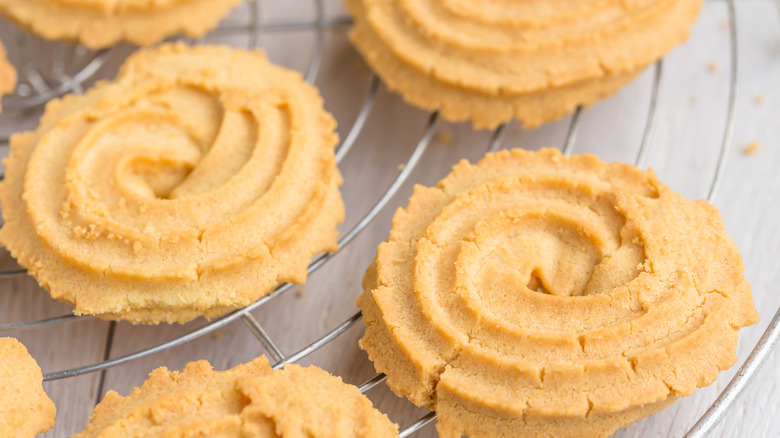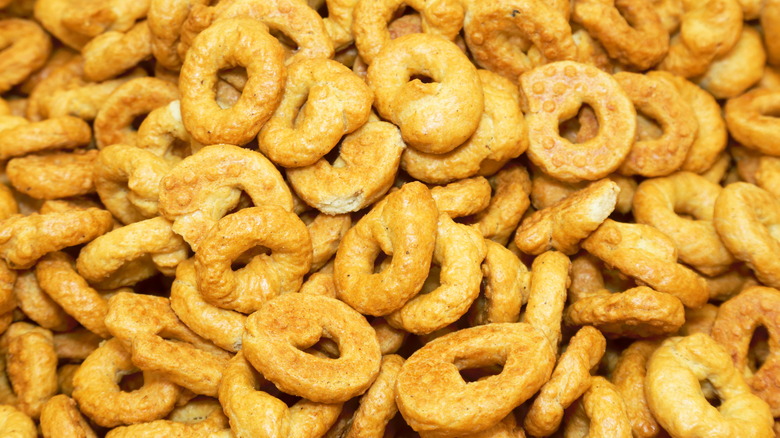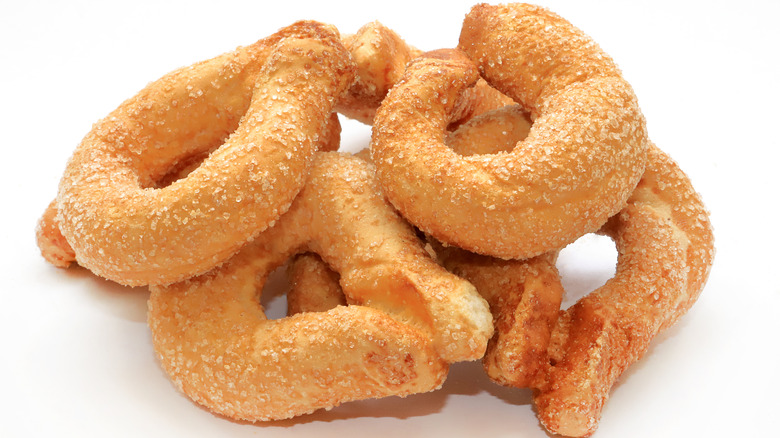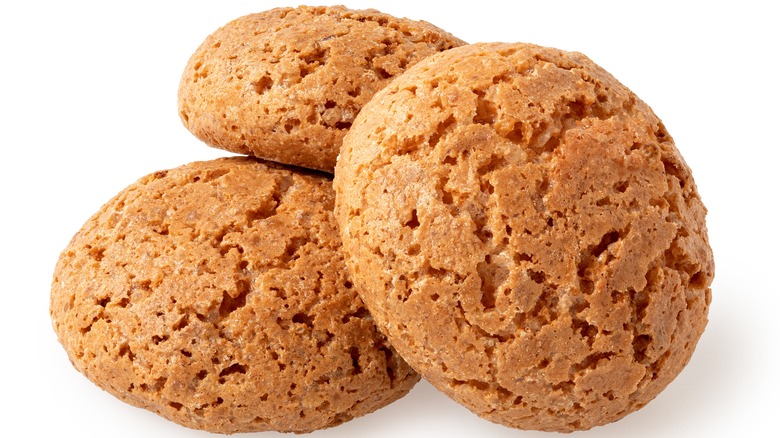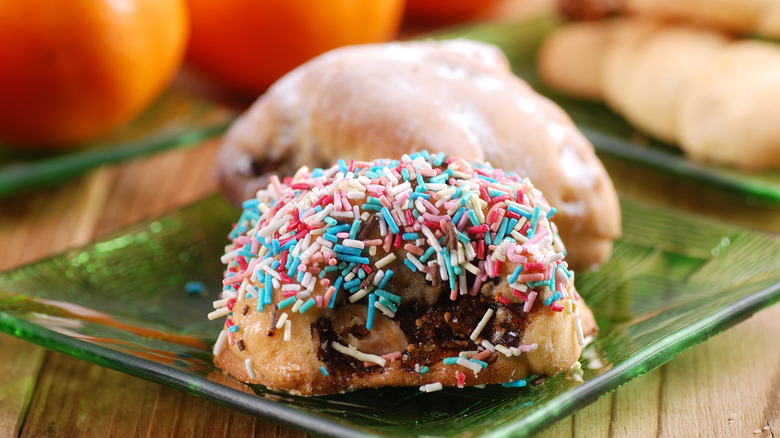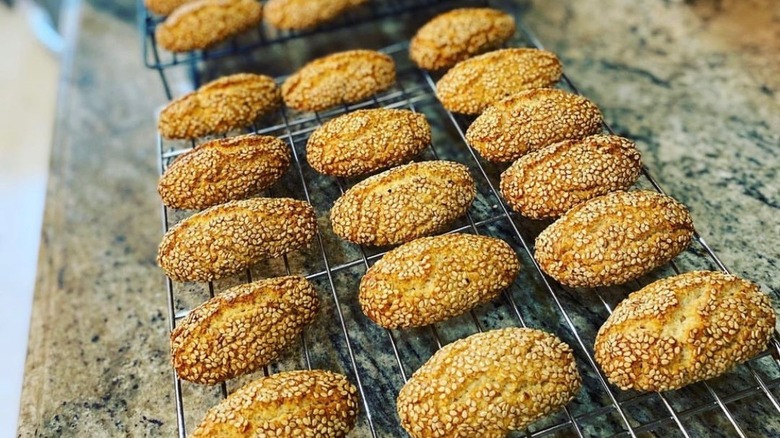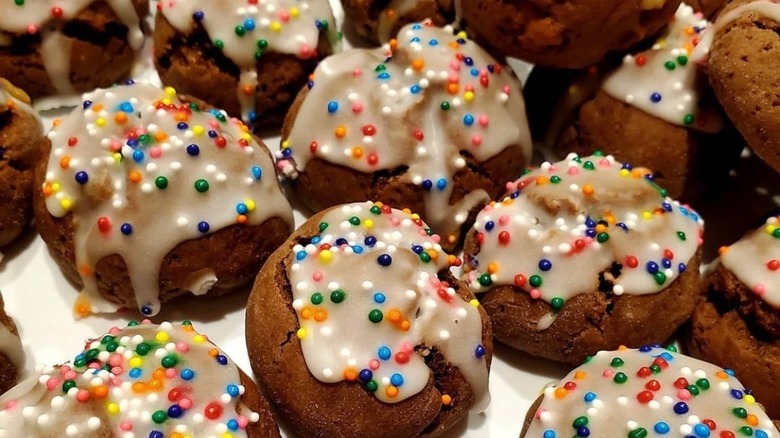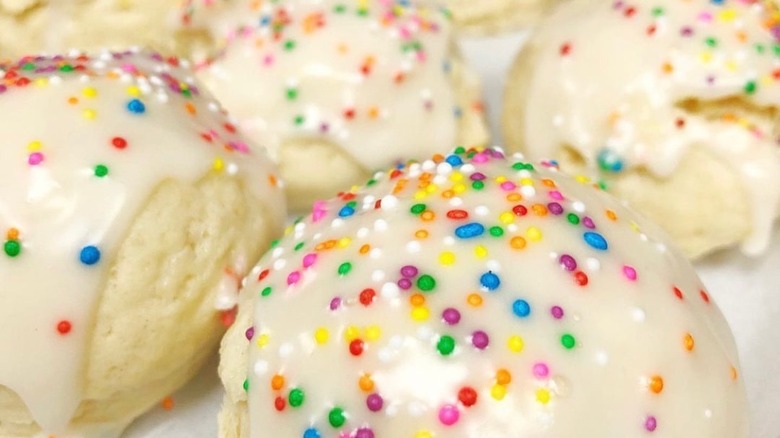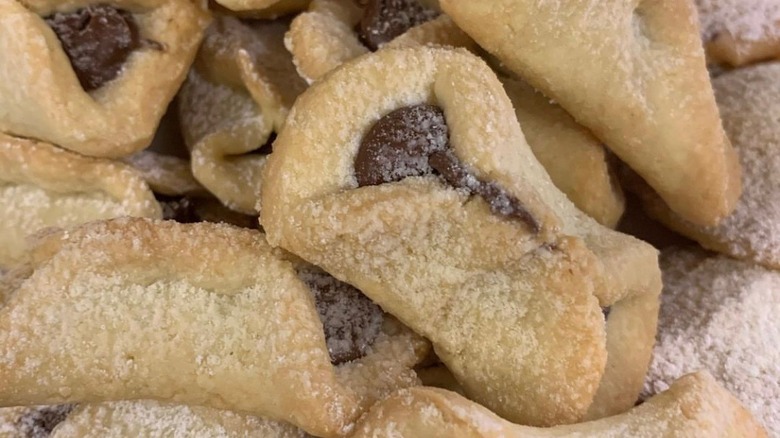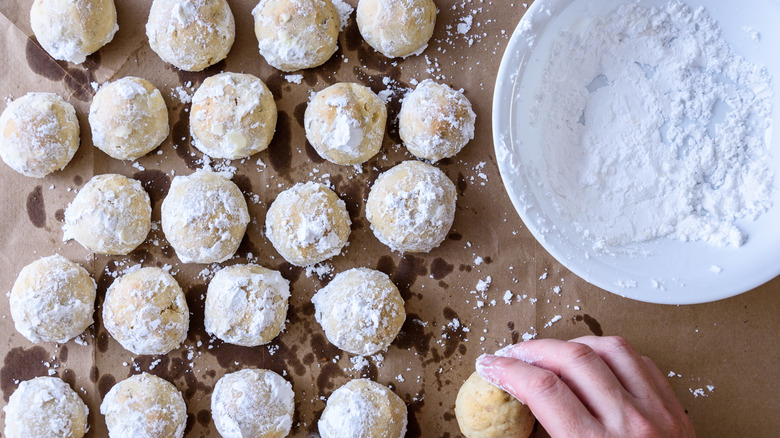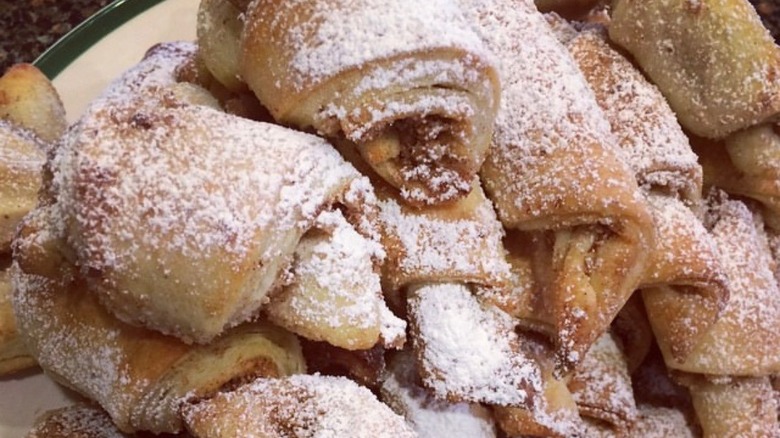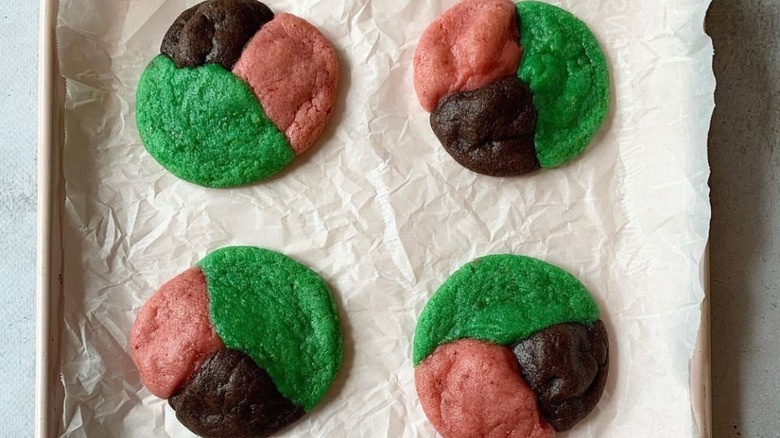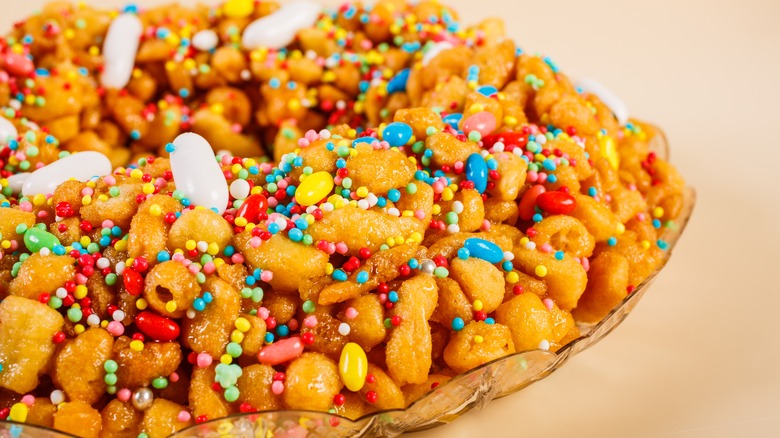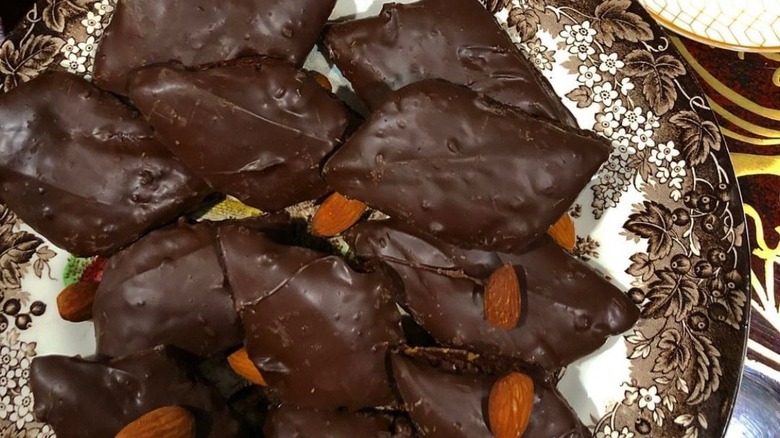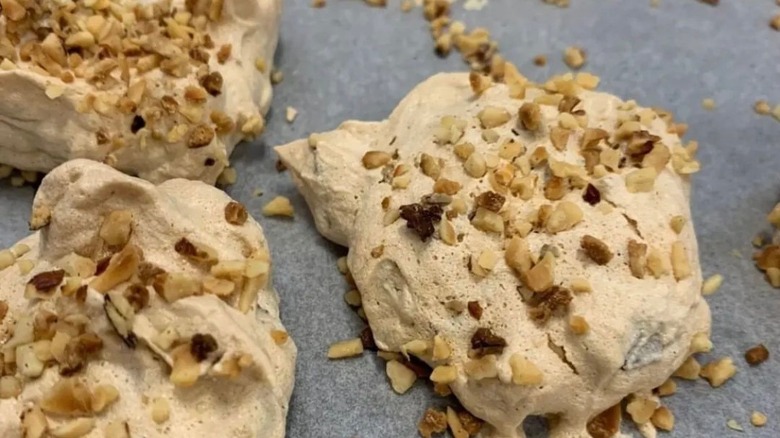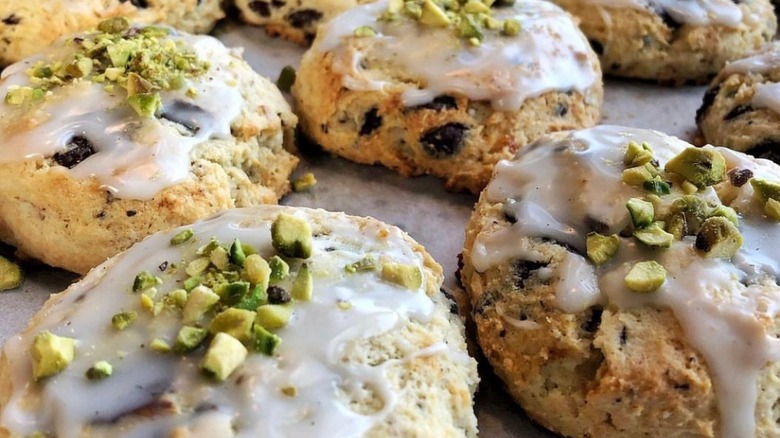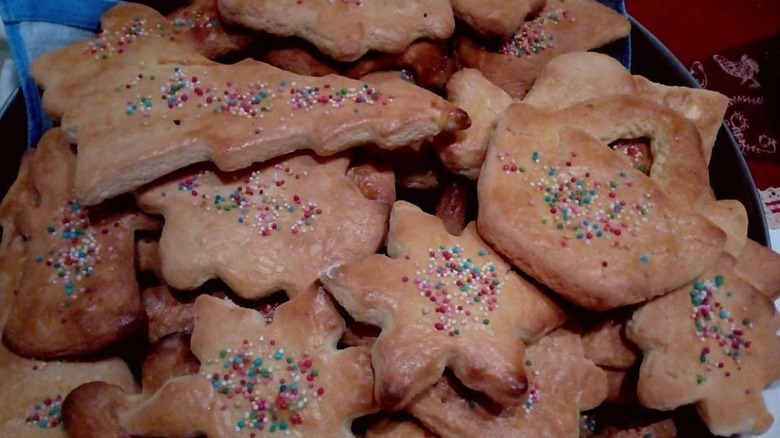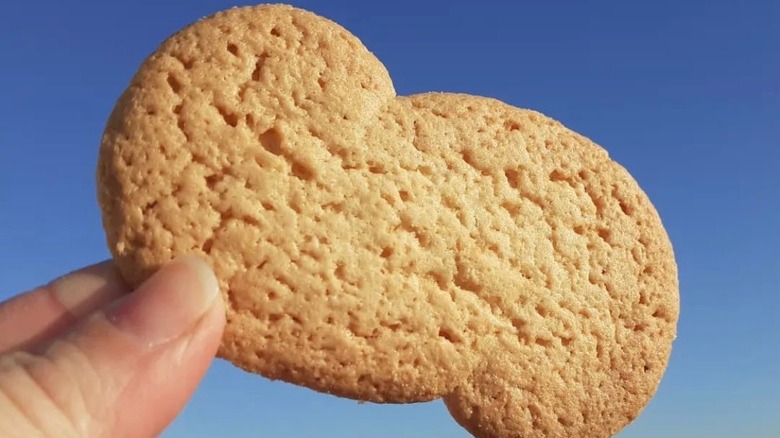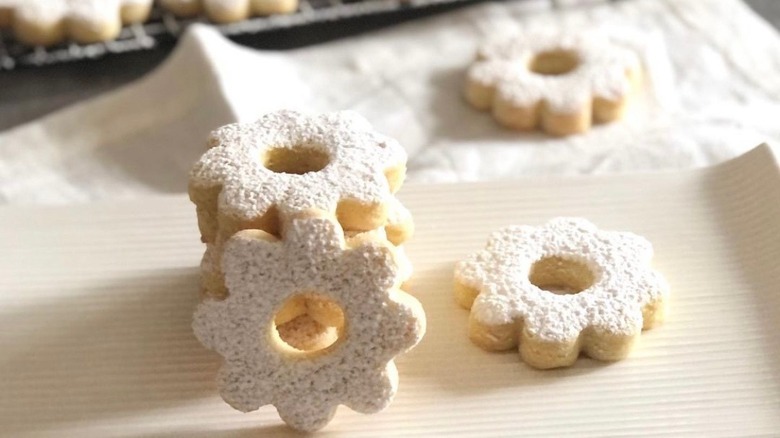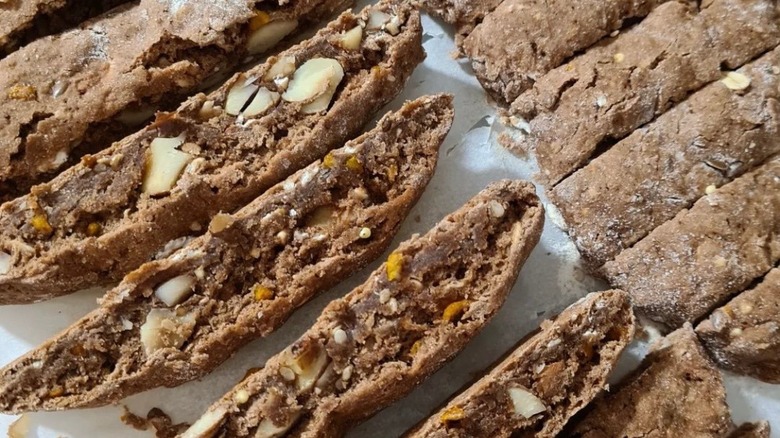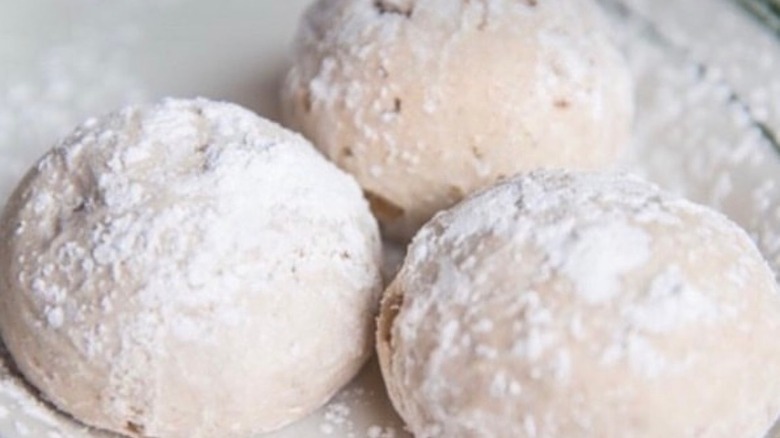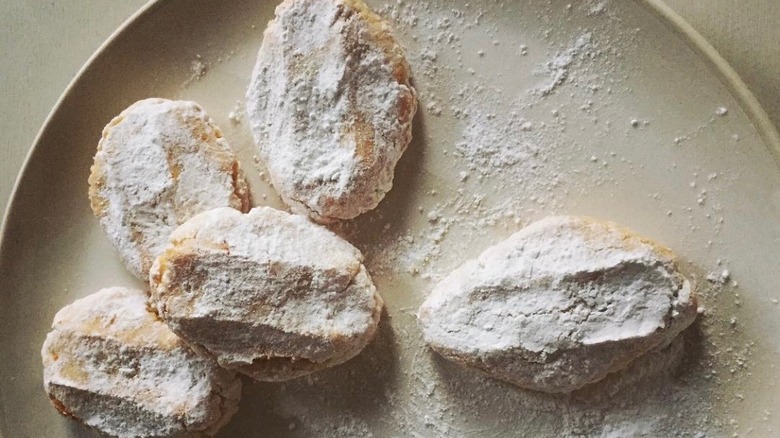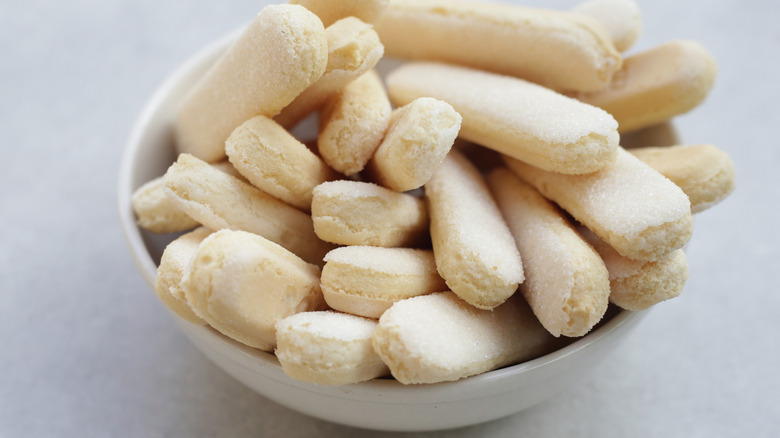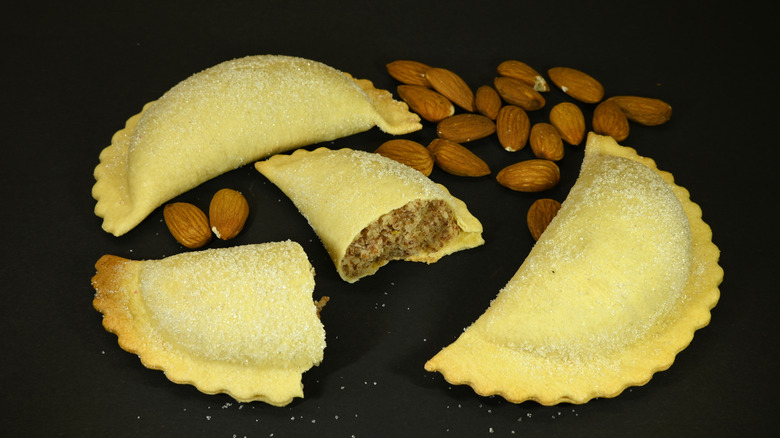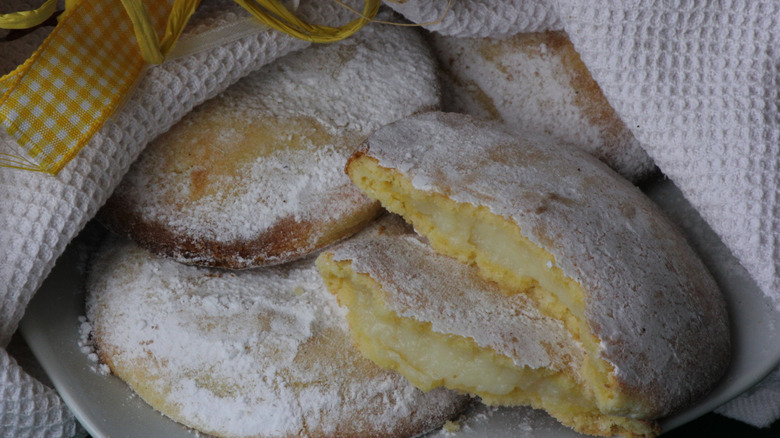35 Types Of Italian Cookies You'll Want To Bake
We've never met a cookie we didn't like. And the same goes for any cookie from the delicious genre of Italian baking. Food is an important part of Italian cultural traditions and is used to symbolize a variety of pivotal life milestones, holidays, and family gatherings. For Italians, food symbolizes love and care — that's why it's not uncommon to see Italian families across the world eating Sunday pasta dinners with friends and loved ones. And there's no better way to finish off a meal than with sweet Italian cookies.
When working with Italian cookie recipes, you'll want to be sure to first read the recipe and the number of cookies you can expect. Many Italian recipes make upwards of five dozen cookies, so unless you have friends and family to share these cookies with, you may be eating Christmas cookies until May. Here are some of our favorite Italian cookies that you can make at home.
1. Pizzelle
The pizzelle is a hybrid between a waffle and a cookie. The batter itself is light, airy, and crunchy, making the pizzelle the perfect cookie pairing for afternoon tea or coffee. To get the signature pizzelle design on the cookie, the batter is poured into a hot metal mold before being pressed. After cooking for around a minute, the cookie is lifted from the press with tongs or skewers with care so as not to destroy the imprinted shape.
2. Biscotti
The phrase "Italian cookie" often conjures the image of a delightful biscotti. This thick cookie gets its shape from being sliced off a dough log after it has been baked. Then, the pieces of biscotti are re-baked to ensure a crispy exterior that is almost bread-like.
Biscotti can come in almost any flavor. In the fall, you may try baking a pumpkin biscotti flavored with pumpkin puree and warm pie spices. For a more adult take on the biscotti, try making honey biscotti with halva for deep undertones of cardamon, the sweetness of honey, and the melt-on-the-mouth flavor of a coconut butter glaze.
3. Fava dei morti
Fava dei morti is Italian for "beans of the dead." These almond cookies are almost found exclusively in Italy and are believed to have originated in Umbria (between Tuscany and Marches). Historically, fava dei morti are eaten between mid-October and All Saints Day on Nov. 1; this is the time of year that Italians celebrate those who have passed away.
Despite the name implying the use of beans, these cookies actually contain anything but. The exact region of Italy will alter the ingredients used. For example, folks in Marche eat fava dei morti cookies that more closely resemble a crispy, rum-infused biscotti.
4. Baci di Dama
Chocolate hazelnut spread lovers — this one is for you. The Baci di Dama cookies are endemic to Italy's Piedmont region. They're made with an almond-flavored dough and filled with a layer of chocolate and hazelnut spread. You might also hear these cookies referred to as "lady's kisses" because the chocolate layer is sealed with a "kiss" of the other piece of cookie. These cookies are smaller than golf balls, so they are the perfect cookie to take on the go or enjoy in the company of good friends and family.
5. Italian sandwich cookies
Italian sandwich cookies are not to be confused with the meaty Italian sub sandwich. These sweet treats are made with a variation on a classic butter cookie. Unlike other cookie types, the thick cookie dough mixture is piped onto a cookie sheet to maintain its delicate shape. Then, the cookies are dipped in chocolate, sprinkles, nuts, or dried fruit. These cookies are relatively easy to make at home because the mixture holds its shape and creates artistically-designed cookie shapes when finished baking.
6. Italian rainbow cookies
The proper Italian rainbow cookie requires some delicate construction work. The cookie is layered to resemble the Italian flag with a layer of red-dyed cake atop a layer of plain cake and subsequent green-dyed cake. Once the cake is stacked and sandwiched with layers of jam, it is covered in a chocolate shell, cooled, and trimmed into small rectangular bites.
This cookie is deceptively easy — just make sure you have a flat-edged measuring tool nearby to ensure all of your cookies are equally sized.
7. Florentine cookies
The Florentine cookie obtained its name from the city of Florence. Florentine cookies have a lacey appearance because they are spread super-thin and are baked until crisp.
Florentines can be drizzled in chocolate or flavored with nuts. Our recipe for Florentine cookie sandwiches with eggnog icing pairs the delicate crunchy Florentine with nutmeg, clove, and rum-infused icing. If you make filled cookie sandwiches at home, though, you should avoid filling the until the very end. This will keep the Florentine crispy and your guests satisfied.
8. Pignoli cookies
Pignoli are pine nuts, and this special ingredient is the perfect nutty component for an authentic Italian cookie. The pignoli cookie is kept light and deliciously soft with the addition of almond paste, sugar, and egg whites. Almond paste is a critical ingredient because of its coarse texture, minimal sweetness, and nuttiness. The egg whites are used to give the cookie its stability while the pine nuts add a nutty flavor and distinguished crunch.
9. Paste di meliga
The paste di meliga is a type of cornmeal cookie native to the Piedmont region of Italy. These mild cookies can be eaten at any time of day and paired with hot espresso, afternoon tea, or fine Italian wine. To make paste di meliga, you'll need to have a star-shaped pastry tip handy to pipe the pinwheels after combining the basic ingredients of corn flour, all-purpose flour, eggs, butter, vanilla, and sugar.
10. Taralli Dolci di Pasqua
Southern Italian Easter cookies, also known as taralli dolci di Pasqua, are sturdy, frosted cookies that get most of their sweetness from an icing layer. The first thing you'll likely notice about these cookies is the sheer size; the cookie is formed by wrapping an 8-inch log of dough around itself. Once the icing is applied, taralli dolci di Pasqua are regularly decorated with sprinkles of varying colors to match the Easter season.
11. Ricotta cookies
If there's something Italians love more than cookies, it's probably cheese. Ricotta provides an added layer of moisture to cookies. The most standard flavoring class usually revolves around citrus. Lemon ricotta cookies are flavored with the addition of both lemon zest and icing with lemon juice stirred in. If citrus is not your favorite, you can venture to make your ricotta cookies your own with your other favorite spices and flavors. For example, you can make pumpkin ricotta cookies spiced with cinnamon, nutmeg, and cloves.
12. Torcetti
Torcetti are the ideal crisp biscuit cookie for afternoon teatime. The torcetti is loved for its hard, bread-like exterior and soft cookie-like interior.
Torcetti are some of the easiest cookies you can make at home. You'll just need all-purpose flour, sifted icing sugar, a leavening agent (like baking soda), cream, and eggs (for color). After the dough is rolled out into a log, it is wrapped around itself, decorated with a garnish of cane sugar, and baked.
13. Amaretti cookies
Amaretti cookies are distinguished by a crusted exterior and soft almond interior. These cookies get a punch of flavor from amaretto, an almond-flavored Italian liqueur. Some bakers will stick to the almond extract instead of rushing for the liquor cabinet, though. These cookies can be hard or soft depending on the amount of time they're baked. The amaretti cookie is also a favorite among gluten-free folks because the ingredients only include egg whites, sugar, almond flour, and your extract (or alcohol) of choice.
14. Cuccidati
Cuccidati Siciliani are Italian cookies stuffed with a fig filling. Per their name, the cuccidati emerged from the island of Sicily. The filling of these small cookies combines soaked figs, marsala wine, dark chocolate, and other dried fruits and nuts for a powerful, almost savory flavor. The sweetened dough casing and confectionary glaze elevate the sweetness of the cookie — meaning that you get almost every kind of flavor in each bite.
15. Italian sesame cookies
Italian sesame cookies originate from Sicily where the treats are often called Reginelle, Regina cookies, or Biscotti della Regina. These cookies are easily identified by a layer of sesame seeds on their exterior; this unctuous ingredient boosts the savory flavor of the cookie and contrasts the sweetness of the cookie dough. Italian sesame cookies are made with shortening or oil, but sticking to classic butter makes these cookies all the more decadent.
16. Italian chocolate spice cookies
Tetù, or Sicilian chocolate spiced cookies, are commonly sweetened with chocolate, cinnamon, cloves, and nutmeg, among other ingredients. There are some regional differences in how tetù are prepared. Some variations on the recipe may include chopped walnuts or almonds, while others omit the nutty flavors. They're easily recognizable from their dark color and are sometimes referred to as "meatball cookies" in the United States. They're commonly topped with a vanilla glaze and colored sprinkles.
17. Anisettes
Italian anise cookies (also known as anisettes), are small sugar cookie balls flavored with anise extract and decorated with a glaze and colored sprinkles. Anise extract gives a distinct licorice undertone to these cookies. It's possible to substitute anise for vanilla (for a more sugar cookie-like taste), almond, or citrus extract — but anise extract provides a much more pronounced flavor that makes the anisettes unique.
18. Italian pinch cookies
Italian pinch cookies are also known as pizzicati, bow tie cookies, or envelope cookies. These buttery cookies are easily identified for the pinching shape at the center of a sea of jam, fruit spreads, or nut butters. The cookie itself resembles a thin jam thumbprint with a soft, buttery flavor and is often eaten around holidays or served with coffee. You can use a variety of jams for pizzicati, but the most common are apricot or raspberry.
19. Italian wedding cookies
Italian wedding cookies are similar to wedding cookies from several cultures. Despite their name, these simple treats are not as complicated and intricate as a wedding. You can make these cookies plant-based by using plant-based butter instead of regular butter or substituting chopped pistachios and almonds for the other nuts. Regardless of your which legume you prefer choice, these cookies are bolstered by large bits of nuts.
20. Italian butterhorn cookies
Italian butterhorn cookies resemble thin, long cinnamon rolls. These cookies are flavored with cinnamon sugar and walnuts, thus resulting in a sweet nutty bliss that pairs well with coffee or tea. The ingredients may be simple, but the process isn't. The rolling technique is critical to making sure the outside of the cookie crisps up while the inside maintains a soft, pillowy, and delicate texture. If they're not quite sweet enough, a light dusting of powdered sugar will do the trick.
21. Spumoni cookies
Much like spumoni ice cream, the spumoni cookie is made of three distinct layers — pistachio (green), vanilla (white), and cherry (red). Those flavors are the most common, although some are occasionally swapped out. After the standard cookie dough is made, it is divided and flavored before being layered on top of each other in a dish. Then, the cookies are sliced into quarter-inch pieces and placed flat on a baking sheet to bake.
22. Struffoli
Struffoli are honey-covered dough cookie balls shaped in a ring. This holiday dessert, usually eaten around Christmas, has roots in the Campania region of Italy (but some historians argue the dish has connections to Greece). Traditionally, the balls are flavored with anise extract, but we recommend using Grand Mariner instead for a more pungent citrus undertone.
After the dough balls are fried and coated in a honey syrup, the plate is usually decorated with a bit of powdered sugar and sprinkles. These treats are perfect for a party because of the small shape of the individual fried dough balls.
23. Mostaccioli
Mostaccioli are heavy on the chocolate, but these cookies also gain a lot of flavor from the addition of honey (and we mean a lot of honey). Some recipes call for chopped almonds and citrus to further flavor the cookies and contrast with their exterior chocolate glaze. These cookies have a distinct flavor that's hard to miss, but their rhombus shape is unique as well and one of the easiest ways to identify them.
24. Uncinetti
Uncinetti are yet another type of Italian Easter cookie. These, however, are similar to sugar cookies — just with the addition of a zesty lemon glaze. Uncinetti translates to "crochet" in English, which makes sense, as these cookies are shaped by wrapping the dough into a spiral (similar to a cinnamon roll). The dough isn't overly sweet, so despite their festive glaze and adornment of colored sprinkles, these cookies are usually eaten around breakfast rather than dessert.
25. Brutti ma Buoni
Brutti ma buoni roughly translates to "ugly but good," and these cookies confidently live up to that name. Regional variations of the cookie have different ingredients and flavors, but the most common staple additions to brutti ma buoni include egg whites, sugar, and nuts. Hazelnuts and almonds are the two most common flavorings, but recipes can contain other types as well. Other variations include the addition of orange extract, chocolate, and vanilla.
26. Cannoli cookies
If making a homemade cannoli isn't your idea of a fun time (believe us, it's harder than it looks), you may consider cookie-ifying this traditional Italian dessert. Cannoli cookies are flavored with pistachios, chocolate chips, orange zest, cinnamon, and nutmeg. The cookie derives its moisture from ricotta and can be decorated with powdered sugar. Although some folks might say it's cheating, we just think combining a cannoli and a cookie is just getting the best of both worlds.
27. Befanini cookies
The Befanini cookie is a Tuscan Christmas staple. baked around Christmas. The exact recipe for the Befanini cookie varies based on family, but the typical ingredients resemble a sugar cookie. They commonly take the typical cookie shapes you see around the holidays, from stars to snowflakes to Christmas trees. Its name is derived from the La Befana, a witch-like creature who brings gifts to Italian children during Epiphany celebrations in early January.
28. Esse di Raveo
The esse di Raveo (the "S" of Raveo) is named after the small town of Raveo in the province of Udine. These Italian biscuits are made of simple sugar cookie ingredients like flour, butter, eggs, sugar, and salt, then shaped into an "S" shape before baking. Some recipes flavor the cookies with a bit of lemon zest as well. This cookie is commonly eaten for breakfast because of its mild, sweet taste that can be easily softened in coffee or tea.
29. Canestrelli
A canestrelli is an Italian egg yolk shortbread cookie. Canestrelli roughly translates to "little baskets," and they're flavored with strong lemon essence — though some recipes will use orange essence instead. The key to this recipe is using hard-boiled egg yolks for color and to make the dough friable. Canestrelli are commonly cut using a flower-shaped cookie cutter with a poked hole in the middle (you can use a straw for this).
30. Susamielli
Much like esse di Raveo, susamielli are regularly baked with a distinctive "S' shape. But unlike its northern cousin, Susamielli are Neopolitan and are flavored with the addition of cloves, cinnamon, and nutmeg. Honey, however, is the key ingredient here. Its sweetness is the clear focal point but doesn't overshadow the other ingredients. During the holiday season, it's common to see the cookies dunked into coffee or sweet wine, which helps soften the susamielli's hard texture.
31. Cavallucci
In Italian, "cavallucci" roughly translates to "little horse," which these cookies used to be shaped like. There are regional variations on the cavallucci, but these cookies are generally crunchy, eaten around Christmas time, and flavored with cloves, cardamon, coriander, nutmeg, anise, and other similar spices. Some of the cookies are also coated in flour rather than powdered sugar, which contributes to a more rustic appearance and lets the flavors of the cookie itself shine through.
32. Ricciarelli
Ricciarelli are a bit odd looking, but like many other Italian cookies, sport a characteristic dusting of powdered sugar to up their sweetness factor. They're flavored with both bitter and sweet almond paste, sugar, and egg whites. The strongest flavor of these cookies, though, usually comes from candied orange peel and the aforementioned icing sugar. Ricciarelli are usually enjoyed with wine around Christmastime.
33. Savoiardi
If there's one type of Italian cookie that you may be familiar with, it's savoiardi, though it's rare that you hear them called by this name. Instead, you may know them as ladyfingers — you know, the tasty biscuits dipped into coffee and layered in a classic Italian tiramisu. While tiramisu is likely their most well-known use, they also make an appearance in other desserts, including trifles and Charlotte cake, and can be enjoyed solo with a cup of coffee or tea. These cookies are soft and easy to bite into, though the longer they're allowed to sit out and be exposed to air, the drier, crispier, and more absorbent they will become.
The ingredient list for these cookies is pretty simple; you have your flour, sugar, salt, eggs, and vanilla extract. The eggs are separated, as the whites need to be adequately beaten in a stand mixer so that they can help aerate the batter and make for the cookie's soft texture and bite. The cookies are piped onto a baking tray in thin, finger shapes before being baked until they're well-risen yet still pale. While they're not the most flavorful of Italian cookies, they have a special place in the hearts of many.
34. Ravioli dolci
Are these ravioli dolci just sweet ravioli? As their name would suggest, that is exactly what they are. They walk a very thin line between being a pastry and a cookie, so you may hear them referred to as both.
Ravioli dolci are a staple food for Carnival in Italy. Like regular ravioli, they're made by filling a rolled-out dough with a cheesy, albeit sweet, filling. Though, unlike classic ravioli, these sweet treats are usually either baked or fried. While some regions will also boil their sweet ravioli, just as they would normal pasta, it seems that the predominant preparations are baking or frying.
The classic filling is made with ricotta, sugar, egg whites, and chocolate chips, though you might find some variations made with roasted almonds and jam or prunes and figs, too. Sicilian Cassatelle, a version of ravioli dolci, may also include marsala or sweet wine in its filling. While the filling can vary depending on the region the recipe comes from, the ingredients used for the dough typically remain the same. In some respects, it's similar to typical pasta dough, as it's made with eggs and flour — though some recipes will also make it more like a pastry or pie dough by adding in butter and sugar.
35. Genovesi Ericine
Genovesi Ericine toe the line between being pastries and cookies, but we think they're cookie enough to warrant a spot on this list. These dainty, pastry cream-filled delights are from the Sicilian town of Erice and are often enjoyed alongside coffees and cappuccinos. The person believed to first have come up with these cookies was Maria Grammatico, who spent years of her life working in the kitchen of the monastery of San Carlo. The cookie's shape was supposedly inspired by the headdresses worn by Genovesi sailors — all down to the icing sugar they're commonly topped with.
The shortcrust pastry base is relatively simple to make, and it's similar to the pastry used in other desserts from around the world. Butter, sugar, flour, and leavening agents are combined until a soft, pliable dough forms. The dough is stamped out with special cookie cutters before being filled with a layer of lemony pastry cream and topped with another layer of shortcrust pastry to assemble a hand pie-esque cookie. Lemon pastry cream is the most common and popular filling for these treats, though you will see some other fillings pop up from time to time.
